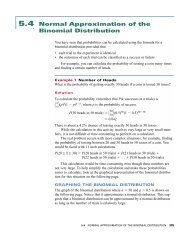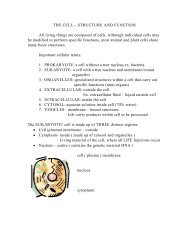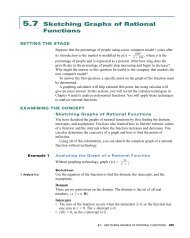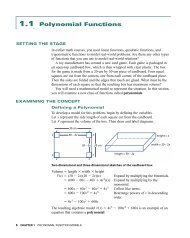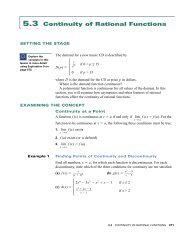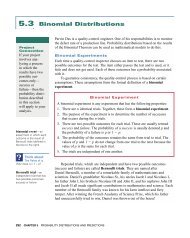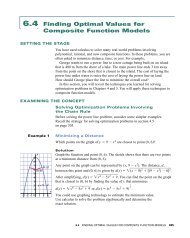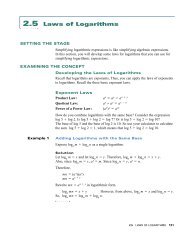1.3 Creating New Polynomial Functions: An Introduction to ...
1.3 Creating New Polynomial Functions: An Introduction to ...
1.3 Creating New Polynomial Functions: An Introduction to ...
Create successful ePaper yourself
Turn your PDF publications into a flip-book with our unique Google optimized e-Paper software.
(b) What does the function D(C(p)) represent if a pair of shoes has a regular<br />
price of $80 Determine D(C(80)).<br />
(c) What does the function C D represent for a pair of shoes with a regular<br />
price of $80 Determine C D for the same pair of shoes.<br />
(d) Does C D D C Justify your answer.<br />
Solution<br />
(a) C(p) p 15 and D(p) 0.8p<br />
(b) D(C(p)) means the coupon is applied first and then the<br />
discount is applied <strong>to</strong> the cost of the shoes. So, when p 80,<br />
D(C(80)) D(80 15)<br />
D(65)<br />
0.8(65)<br />
52<br />
(c) C D means the discount is taken first and then the coupon reduction is<br />
applied. When p 80,<br />
(C D)(x) C(D(80))<br />
C(0.8(80))<br />
C(64)<br />
64 15<br />
49<br />
(d) In this case, C D ≠ D C. The order of composition makes a difference.<br />
When p 80, D(C(80)) 52 and C(D(80)) 49. In fact, these two<br />
functions are different.<br />
(C D)(p) C(0.8p) (D C)(p) D(p 15)<br />
0.8p 15 0.8(p 15)<br />
0.8p 12<br />
CHECK, CONSOLIDATE, COMMUNICATE<br />
1. Explain how a new polynomial function can be made from two<br />
polynomial functions by addition, by subtraction, and by multiplication.<br />
2. State ( f g)(x), ( f g)(x), ( f g)(x), and f (g(x)) for<br />
f {(1, 4), (0, 5), (6, 3)} and g {(1, 6), (0, 9), (4, 2)}.<br />
3. Determine ( f g)(x), ( f g)(x), ( f g)(x), and f (g(x)) for<br />
f (x) x 2 3x 2 and g(x) x 3.<br />
<strong>1.3</strong> CREATING NEW POLYNOMIAL FUNCTIONS: AN INTRODUCTION TO COMPOSITION 33



